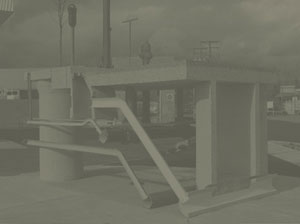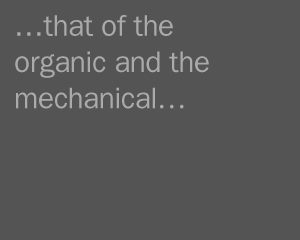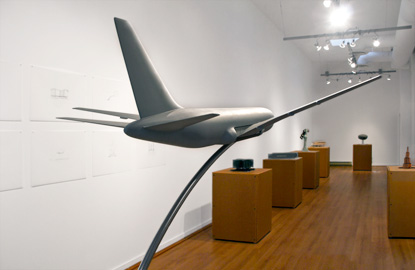Stephen Horne
Border Crossings, Volume 31, Number 2, June July August 2012, pp. 94-96.
In Vancouver artist Greg Snider's exhibition of recent "Projects" at Deluge Contemporary
Art in Victoria, we encounter precisely but plainly made models. These models are not
particularly pretty but are often hypnotic by virtue of their mechanized and repetitive
movements, a sense of autonomous motion like that of our giant windmills. In Project
For the Tar Sands, dirty oil oozes downward from the top of a Tatlinesque stack of tubes.
In Project for an Airport we are confronted by a "mechanical bird," a giant Boeing 767
miniaturized and flapping its wings, slowly. Eight such "Models for the Public Sphere"
line up along the gallery walls, accompanied by ten "sculptor's" drawings.
In Project For a Holocaust Memorial, Snider has united multiple railway boxcars into a
single cruxiform, a regular iron cross. This icon forms a spatial configuration
emphasizing the horizontal and the vertical vectors of three dimensionality. The
systematic aspect of modern management and production techniques has been
compared to the procedures by which the concentration camps were managed.
Holocaust proposes that we consider "the monstrous" as an outcome of such rationalist
systems.
In Project For a Troller, Snider has collaborated with an amateur model builder rather
than using readymade model kit elements. A former fish-boat operator D. Allen (whose
name is on the model) now handcrafts highly detailed and knowledgeable miniature
memorials to his former occupation as a fisher person. Snider has, with Allen's
assistance, modified one of Allen's fishboat models, presenting a cut-away version
magically sliced stem to stern, top to bottom. This one-half boat now exposes the inner
workings of the troller with its controls and its living space totally present to the viewer's
gaze, but what is more interesting is the sense of possession that accompanies the
penetrating gaze facilitated by this cut-away didactic demonstration.
In the word "demonstration" we can see both "monster" and "monstrate," leading to
"monstrous watching." The intersection of these terms is highly pertinent to what
happens in Snider's models; they capture us for watching, in some cases almost
hypnotically, as in the Project For an Airport automaton, the plane with wings that flap
in an ineffable and sinister regularity. There is both a sense of monstrosity but also the
feeling of power that accompanies acts of demonstration, of showing the inner workings
of something. No doubt these characteristics align with the uncanny or that weird sense
of power we can get from seeing inside "the thing."
In this way Snider has taken on social topics such as the destruction of the environment,
and the isolation of art but he does this by way of a vernacular vocabulary and a critical
populism. This ideological orientation of his work aligns him with Hans Haacke but
there is in his Projects a sense of wonder and the monstrous that both seem to emanate
from the world of model building, perhaps due to its proximity to the world of childhood.
For example, in the beautifully built Project for False Creek/Vancouver Special Sawmill, Snider
has combined in the most literal way a monument to Vancouver history (a portable
sawmill) and the product of such a sawmill (a generic Vancouver bungalow), the house
perfectly poised overhead like a second story over the mill, the two, permanently and
harmoniously conflicted.
We use the word "model" as noun or as verb and this ambiguity has made it conceptually
interesting for many artists. Models exist as memorials, as proposals and as prototypes.
Tatlin's Monument of 1920 existed only as a proposal for an ambitiously elaborate tower
containing rotating interior platforms. It remained unbuilt but proposing a kinetic
building that would demonstrate modernity's vision of better homes through
engineering, a vision Snider's models hope to undermine even while adopting the kinetic
aspect. The sense of anxiety that emanates from Snider's models is a weirdness that
sometimes appears when we encounter an inert object taking on characteristics of a
living creature.
The Greek artist Takis intervened in natural forces such as gravity, magnetism, and
sound waves with his automated devices. His hypnotic and sinister constructions are
pertinent to the work of Greg Snider as are Hans Haacke's early process sculptures, such
as Condensation Cube, 1963. Takis' and Haacke's works show as temporal relations, such
as that of the organic and the mechanical, and by doing so inspire an awareness of our
own temporal presence, our finitude.
Like many of Takis' kinetic sculptures, Snider's Project for a Fountain combines the
regularity of machine work with the freedom of a natural event, in Snider's case that of a
waterfall. This miniature version of an as yet unbuilt large-scale public monument
presents a massive rock overhead, the rock spewing out an absolutely vertical waterfall
that also functions as a column supporting the rock. This contradictory combination of
stasis and movement is again monstrous, sinister, dangerously unstable an, as such,
serves to model our current relationship with nature and the social milieu.
In his early sculpture Narrow White Flow, 1962, Hans Haacke placed a piece of fabric in
an air jet to demonstrate temporal process in the viewing situation. Another example of
this sort of complex model usage was Agnes Denes/ having grown and harvested Wheat
Field in New York City, 1982. Both of these artists have pointed toward our ways of
mediating or taming nature with automated systems, an orientation pursued in these
new works by Greg Snider.
Alongside Snider's use of fabricated materials there are indicators of a transformation of
what was once elemental into mere natural resource and automated labour. "Models For
The Public Sphere" serves as a reminder that the human being becomes ever more
disposable as we render nature and its forces simply a resource.





Models for the Public Sphere: Tar Sands, Aircraft, Holocaust...
Deluge Contemporary Art, Victoria, BC, January 27 - February 25, 2012
Deluge Contemporary Art, Victoria, BC, January 27 - February 25, 2012
gregsnider.ca Copyright © 2007 - Greg Snider.
All Rights Reserved. contact: greg@gregsnider.ca




